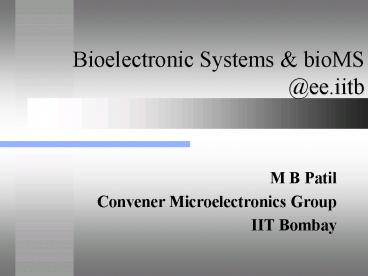Bioelectronic Systems - PowerPoint PPT Presentation
1 / 20
Title:
Bioelectronic Systems
Description:
... groups attached make the porphyrin water soluble I-V curves obtained In conclusion There is frenetic activity in the bioelectronics and bioMS area at IITB ... – PowerPoint PPT presentation
Number of Views:726
Avg rating:3.0/5.0
Title: Bioelectronic Systems
1
Bioelectronic Systems bioMS_at_ee.iitb
- M B Patil
- Convener Microelectronics Group
- IIT Bombay
2
Definitions
- Bioelectronic Systems Systems that utilize a
bio-object or operate on bio-objects for their
function. - BioMS Microfabricated systems (MS) that utilize
bio-objects or operate on bio-objects for their
function.
3
Concluding Remarks about this area in AIM 2002
- IITB is one of the few places in the country
which has demonstrated collaborative work in the
area of bio-instrumentation bio-sensing systems - These have been demonstrated by student projects
and modest consultancy and sponsored projects - Need projects with critical funding levels to
take these ideas to the field and is actively
seeking funding and collaboration ? We have got
this support this year - The academic-research structure in the institute
is conducive for the realization of the above
objective that would create both locally useful
bioMEMS based diagnostic systems and globally
appreciated new knowledge
4
Projects in this area
- A major sponsored project by NPSM on bioMS for
Cardiac Markers we have called this sensing
system iSens - Smaller and internally funded projects in
biomolecular electronics and electroporation
FOR MORE INFO...
A site on iSens will soon be up
5
iSens Project Goals
- The ultimate goal of the project is to design
prototype - A Point of Care Assay System for Molecular
Markers for Myocardial Infarction - Would involve
- Design prototype of processes
- Design prototype of structures
- Integration of system for quick assay of cardiac
markers - Testing of the devices and systems at various
stages of the development - Overall protocol testing
- Team Timeframe
- Multi-departmental team
- Project duration 30 months
6
Molecular Markers
- Enzymatic markers
- Creatine kinase-Total (CK)
- Creatine kinase MB (CK-MB)
- Lactate dehydrogenase (LDH)
- Aspartate aminotransferase (AST)
- Glycogen phosphorylase isoenzyme BB (GPBB)
- Protein molecules
- Troponin
- Myoglobin
- Cell-free DNA fragments
- Will try the molecules in blue
7
Conventional Approaches
- Sequential assays
- Immunoassays
- ELISA (Enzyme Linked ImmunoSorbant Assay)
- Radioimmunoassay
- Immunoprecipitation
- Chromatography (!)
- Electrophoresis for separating isomers and then
looking for activity (for lab (skilled labor,
time consuming))
8
New approaches
- Biosensor array based or microfabricated
sequential assay system based - General approach is to use affinity sensors
- Some modern direct affinity sensors
- Quartz crystal microbalance
- Surface plasmon resonance
- Affinity cantilevers
- Conducting polymer devices
- EIS capacitors
9
Functional Architecture of iSens
Input Filter
Sample
Signal Conditioning Display
Biosensor Array
Reactor
Control Processing Electronics
Reagent
10
Flavour of Biosensor Array Affinity Cantilevers
- Based on resonating structure 0r deflection
- ?Attachment changes mass or stiffness of
resonating structure and thence resonant
frequency - ?Attachment changes bending of the cantilever
11
Flavour of BiosensorArray Conducting polymer
FETs
- Inter-digitated noble metal electrode covered
with conducting polymer - Conductance change occurs with change of state
(such as change of pH in enzyme catalyzed or
affinity reaction) that can be used for sensing
12
Flavour of Biosensor Array ISFET based
- Attachment of ions to naturally occurring surface
sites or ionophores attached to the surface of
the dielectric of a FET-like device - ? Changes channel charge thence drain current
- Could be used in the constant drain current mode
or constant gate voltage mode
13
Team Resources
- People A team of about 24
- Equipment About Rs 2 crore for equipment,
includes e-beam lithography, AFM, HWCVD,
14
Status
- Have got started working to have the devices
ready - This is how a microcantilever looks
15
A whiff of a smaller project
- A student project, but with faculty and research
scholar support form Chemistry Electrical
Engineering - Aim Try to see how a gold-single molecule (a
porphyrin synthesized in Chemistry) behaves as a
diode - Deposit gold on SiO2, Deposit a SAM monolayer,
study IV characteristics with a STM
16
Preparation and Characterization of the gold film
- - Prepared using Physical Vapor deposition
process - Cleaned using the Piranha solution to remove
organic impurities - XRD spectrum taken to analyse the crystal
structure - lt111gt crystal structure observed
- STM/AFM pictures taken to gauge surface smoothness
1000nm x 1000nm scan Features height lt 1nm
17
Porphyrin Molecules
- Porphyrin Molecule attatched with a thiol group
protected by an acetate group - Formation of SAM in-situ cleavage of the S-Ac
bond - Metallo-porphyrin selected due to its
intercalating properties with DNA - The methyl groups attached make the porphyrin
water soluble
Tetra Methyl Pyridyl Zinc Porphyrin Thiol
Acetate
18
STM Images
Ridges type structure obtained in the first
figure (10nm x 10nm scan) Valley of depth 1nm
observed in the second image (50nm x 50nm scan)
19
I-V curves obtained
Diode type characteristics with a barrier
potential Measurements taken on the hill shown
before
20
In conclusion
- There is frenetic activity in the bioelectronics
and bioMS area at IITB - Need to create more awareness of the
applications of this new area - Need to increase interaction with user agencies































